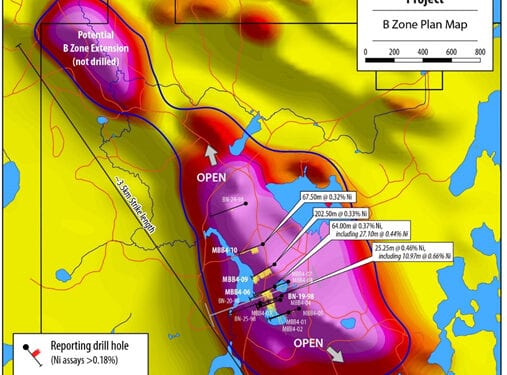Identifies Potential for Bulk Tonnage Nickel Deposit In Ontario
Grid Metals Corp. (TSXV:GRDM) has received an independent technical report into historical exploration activities at the Bannockburn Nickel Sulphide Property located in the Matachewan area in Ontario, Canada.
The technical report was commissioned in order to summarise all relevant geological and historical exploration information on the Bannockburn Property (including 84 drill holes) and obtain independent recommendations for future exploration at the Property.
The Property mineral rights are held 100% by Grid Metals by way of 125 contiguous unpatented mining claims that cover approximately 2700 hectares and are subject to a 2% NSR held by Outokumpu Mining.
Key findings of the report included:
- The style of mineralisation present in the B Zone (Mount Keith-type) at Bannockburn is directly comparable to the large-tonnage, low-grade nickel sulphide resources hosted by the Crawford Ultramafic Complex (CUC) on the Crawford Nickel-Cobalt Sulphide Project and the Dumont Nickel Deposit.
- The property shows good potential for developing both low-grade, large tonnage and high-grade, low tonnage nickel (Co, Pt, Pd, Fe) resources and warrants additional exploration given similarities of initial drill intersections, in terms of grade and thickness, to that reported in the Main and East zones at the Crawford Nickel Project.
- Disseminated nickel mineralisation was intercepted in 10 historic drill holes over a 350m strike length in the B Zone.
- Drill hole MBB4-09 assayed 0.327% Ni over 202m starting at the top of the bedrock surface and bottomed in mineralization. For reference this nickel grade is similar to the grade reported from the Main Higher Grade Zone Measured and Indicated Resources of the Crawford Nickel resource.
Dr Dave Peck, the company’s Vice President of Exploration and Business Development, said rhe immediate priority at Bannockburn is to determine the continuity and potential size of the known Mount Keith-type disseminated nickel sulphide mineralisation hosted by the B Zone.
“We believe that the B Zone is directly analogous to the large mineral resources that Canada Nickel has defined at Crawford,” Dr Peck said.
“We will be applying 3D magnetic inversion modelling to existing airborne data to guide the next phase of drilling, given the direct correlation we are seeing between alteration intensity, magnetic response and nickel grade in the B Zone.”
President and CEO, Robin Dunbar, said the growth in demand for nickel is expected to surge with the electrification of automobiles in the coming years.
“Bannockburn represents a high potential project for Grid Metals with multiple zones of nickel mineralisation drill identified,” Mr Dunbar said. “In light of the fundamentals for nickel going forward we view Bannockburn as an excellent project opportunity for Grid to pursue at this time.”












